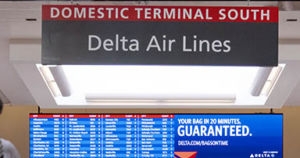Airports have a vested interest in delivering a painless experience to their passengers; after all, happy people spend more money. Delivering on that objective requires an understanding of the pain points these customers feel when they travel through an airport. According to a survey from the global consulting firm Oliver Wyman, frequent fliers consistently rank long lines as their greatest travel irritant. The most successful airports have realized expanding and improving their LED signage integration is the key to alleviating these foot traffic issues. That being said, airports can –and should- do more with their digital signage technology because these LED displays do more to ameliorate passengers’ chief complaint than any other solution. Below, we’ll identify two styles of queues that arise in airports and explore how LED can help improve things in each case.
Security Queues
Ahead of delays, insufficient on-board storage, and flight cancellations, passengers cite long lines as their top air travel annoyance. The key to addressing this issue is understanding its cause. The obvious thought here would be that long lines and crowds arise simply because there are a lot of people in one place. That’s not quite true. These crowds arise because lots of people are in one place trying to do the same thing. That is most obviously demonstrated in the security queues of an airport, where passengers have no choice but to move single file through the tedious process. While LED digital signage won’t necessarily raise the number of checkpoints, add staff, or increase the efficiency of the security machinery, it can improve passengers’ experience throughout this process in two distinct ways.
First is the way in which Changi Airport in Singapore deployed their enormous Nanolumens LED display. Spanning a 70-foot wall surface overlooking the entire security check-in area, this display showcases a constant loop of vibrant visuals that calm and entertain queued passengers while they wait. It doesn’t shorten their wait but it at least improves their mood while they do so. The second way signage can improve the security process is by smoothing passengers’ process of actually getting there. Depending on the size of the airport, locating where you are actually supposed to go can be frustrating. With large, highly visible LED digital signage guiding your way, this will never be a problem. Again, this won’t necessarily decrease the wait time but it will decrease the stress passengers feel prior to joining the line.
Crowded Hallways
While not formally a line, the crowds that congest a terminal’s hallways generate the same irksome effect; passengers are stuck waiting behind others to get what they need or where they need to go. Once through the security check-in, these crowds tend to congregate around the closest flight information display system (FIDS). This signage communicates to passengers their gate, the status of their flight, and thus, the direction they must head next. When this signage is insufficient in size, number, or brightness, passengers will move right from one line to a new one. Airports like Stansted International in London and Toronto Pearson International have introduced a variety of big and bright LED FIDS digital signage in their terminals to disperse these crowds before they even gather. The principle here is obvious; passengers need information and to prevent them from congesting around a single source, airports should make this information as accessible as possible. Large-format LED is the best way to accomplish that.

